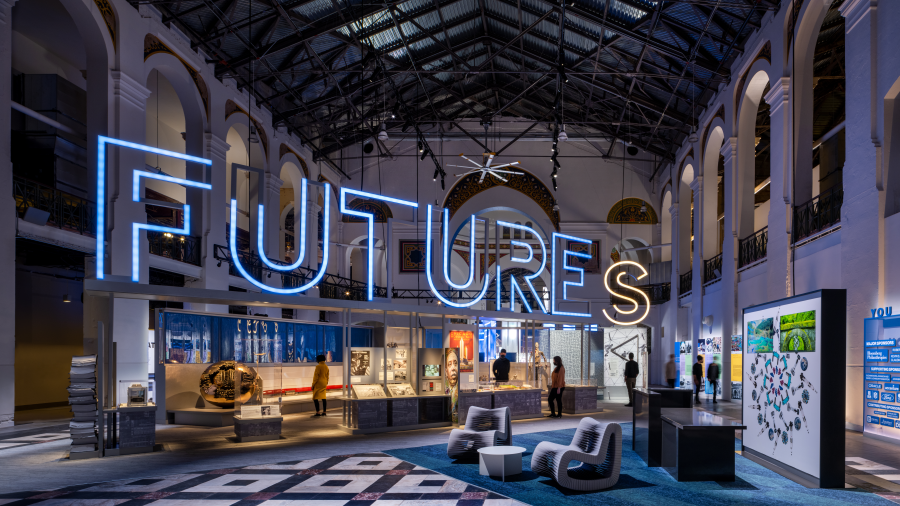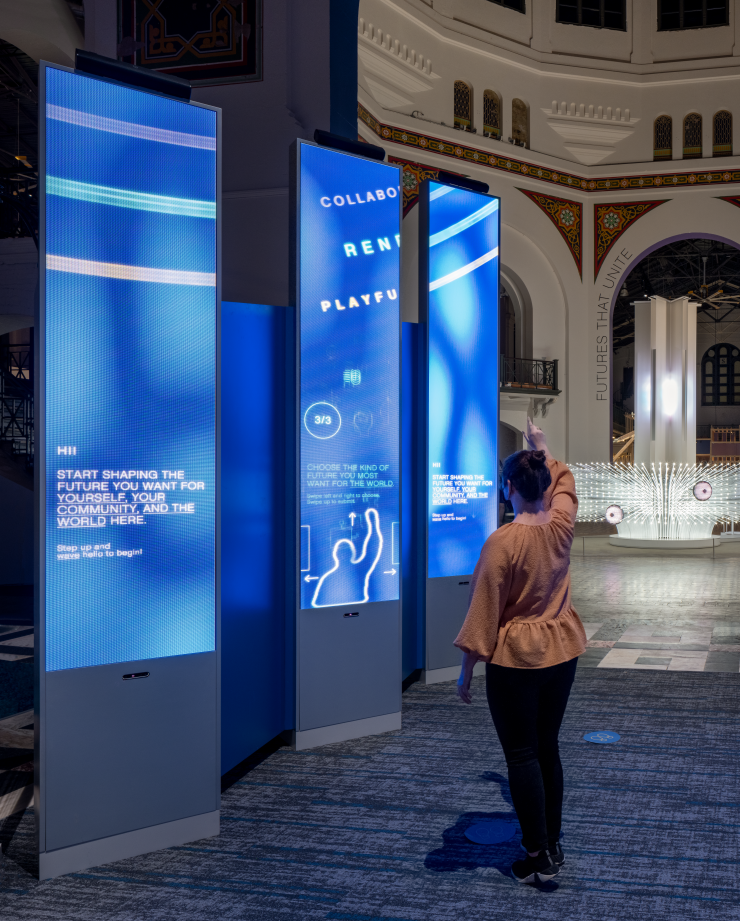Envisioning the future, and the tech it will take to get us there

The Smithsonian Institution’s Arts and Industries Building in Washington, D.C, is helping visitors explore how technology can, and should, shape the world of tomorrow.
We sent Marketplace producer Sasha Fernandez to take her own tour of the “Futures” exhibition.
When you enter the museum, which looks like a cathedral with soaring ceilings, you’ll see the guides — tall, metal columns with colorful screens and a sensor. The museum calls them futures beacons.
Rachel Goslins, director of the Arts and Industries Building, demonstrated how they work.
“All right. So you kind of swoop — you have to do sort of a swooping” motion, she said.

The sensor basically scans your body, and by swooping your arm left to right you can pick answers to several questions, like “What kind of future do you want?”
And with each interaction, the beacon saves your answer.
The museum worked with the design studio Lab at Rockwell Group with support from SoftBank Group Corp., and the Institute for the Future, a think tank, to create this exhibit. It is an effort to get people thinking about the different ways we might interact with technology in the future.
“If you can’t imagine the future you want to live in, then you’re not going to feel very hopeful or empowered to try and get there,” Goslins said.
After interacting with the first beacons, visitors can enter the Futures That Work hall, highlighting tech that could help us tackle everyday problems.
For example, your commute time. If you want to get to work faster, a beacon will direct you to the Pegasus capsule. Here, visitors can get a close view of Virgin’s Hyperloop vessel and even hear audio from one of the initial test rides.
“All right, the vehicle has come to a stop. Captain, please check on the occupants,” the Virgin Hyperloop control room employee said.
It may not be science fiction-style teleportation, but it works. The capsule could transport passengers at more than 600 miles per hour.
There’s also the Futures That Unite hall, where the beacons ask visitors about how we can use technology to better connect and uplift one another.
Museum visitor Karla Wesley said she was struck by a display showing that a future pharmacy could bioengineer insulin on the spot — potentially lowering costs and improving access to the life-saving drug.
“It’s almost like going back to the artisans of the past,” Wesley said. “The alchemists who first made — in medieval times — medicines, but using sophisticated science of today, which is fascinating.”
As you leave the museum, one last beacon gives visitors a chance to inspect and interact with the ideas they shared and the information gathered. It’s updated on an hourly basis to reflect the answers people gave.
During the tour, the beacon’s data revealed that most of the participants believe that 3D printed organs could help save people’s lives in the coming decade.
Marianna Salinas, another museum visitor, said she enjoyed using the beacons for the opportunity to contribute to the exhibit.
“It’s nice to know that you’re leaving behind a little bit of information in the museum,” she said.
Because people don’t want to just let the future happen. They want to help create it.

Related links: More insight from Kimberly Adams
If you want to explore some of the ideas behind the beacons, or play some futurist games, the website for the Institute for the Future, the think tank that helped design those beacons, has some.
And there’s a bunch of interesting technology highlighted in the exhibit that Sasha couldn’t get to in her story, so here’s a link to the exhibition website as well.
One thing Sasha thought was pretty cool — the enormous Bell Nexus vehicle, a prototype for a taxi in the sky.
Very Jetsons-style, if you ask me.
Feb. 11, 2022: This story has been updated to include that the exhibit received support from Softbank Group Corp.
The future of this podcast starts with you.
Every day, the “Marketplace Tech” team demystifies the digital economy with stories that explore more than just Big Tech. We’re committed to covering topics that matter to you and the world around us, diving deep into how technology intersects with climate change, inequity, and disinformation.
As part of a nonprofit newsroom, we’re counting on listeners like you to keep this public service paywall-free and available to all.
Support “Marketplace Tech” in any amount today and become a partner in our mission.


















